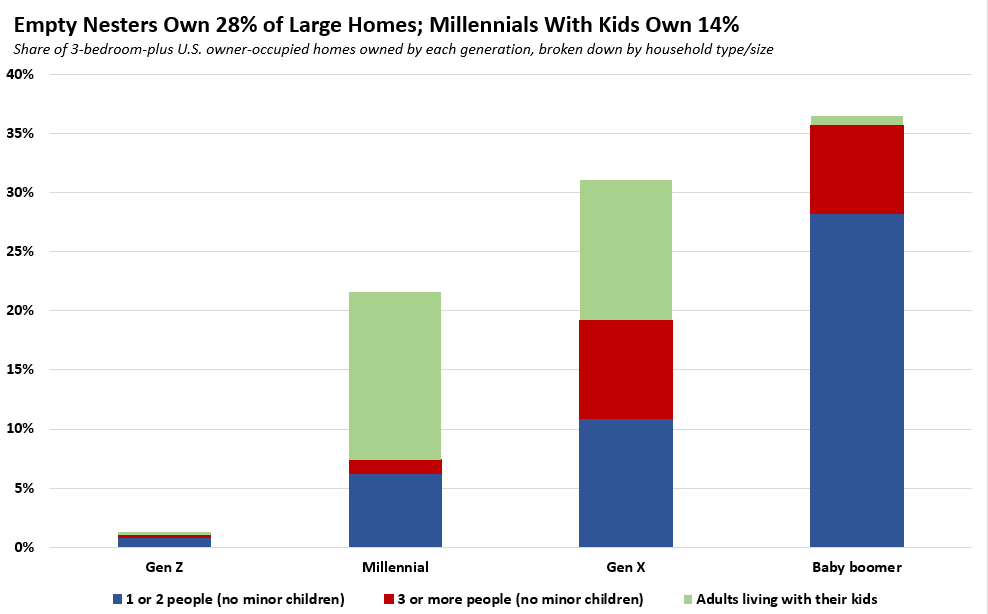According to a new Redfin report, empty-nest (households headed by baby boomers with 1-2 adults living in the home) baby boomers own nearly 3 in 10 (28.2%) large U.S. homes. That’s twice as many as millennials with kids, who own just 14.2% of the country’s large homes, while Gen Zers with kids own almost none (0.3%) of them.
An additional 7.5% of the country’s large homes are owned by baby boomers with households of three adults or more; this category likely consists mostly of adult children living with their boomer parents.
While there are more millennials than baby boomers, millennials with kids own half as many large homes as empty nesters. The millennial generation makes up roughly 28% of the country’s adult population, the largest share of any generation. They’re followed by baby boomers (27%), Gen Xers (25%), and Gen Zers (12%).

Baby boomers own a large share of large homes for several reasons, current and historical:
- There’s not much financial incentive to let go of large homes. Most (54%) boomers who own homes have no mortgage. For that group, the median monthly cost of owning a home, which includes insurance and property taxes, among other costs, is just $612. For the boomers who do have a mortgage, nearly all have a much lower interest rate than they would if they sold and bought a different home with today’s near-7% rates. Even if they downsize, they may have a nearly identical monthly payment.
- For millennials and Gen Zers, it’s harder to find and afford a home. Large homes are in short supply, largely due to the mortgage-rate lock-in effect and a recent lack of homebuilding. Large homes are also hard to afford. 2023 was the least affordable homebuying year on record; it was especially hard for younger Americans who don’t have equity from a prior home.
- Some young Americans don’t want to own a home. A recent Redfin survey found that 12% of millennials who believe they’ll never own a home aren’t interested in homeownership, and 7% said they don’t plan to buy because they don’t want to maintain a home.
- Boomers built wealth. Many older Americans benefited from an abundance of newly built homes and favorable economic conditions during their prime moneymaking years, during the 1990s economic boom. Those homes proved to be good investments. Home values have grown four times faster than incomes over the last several decades. Today, boomers hold half of the wealth in the U.S., and much of it is in real estate.
- Boomers are older, so they’ve had more time to buy homes.
“There’s unlikely to be a flood of large homes hitting the market anytime soon,” said Sheharyar Bokhari, Senior Economist at Redfin. “Logically, empty nesters are the most likely group to sell big homes and downsize. They no longer have children living at home and don’t need as much space. The problem for younger families who wish their parents’ generation would list their big homes is that boomers don’t have much motivation to sell, financially or otherwise. They typically have low housing costs, and the bulk of boomers are only in their 60s, still young enough that they can take care of themselves and their home without help.”
Many young families are renting large homes in the meantime. Millennials with kids take up one-quarter (24.8%) of the three-bedroom-plus rentals in the U.S., the largest share of any generational category, followed by millennials without kids (11.6%). Empty-nest baby boomers take up the next-highest share (11.4%) of three-bedroom-plus rentals.
Some 45% of empty nesters own big homes, almost double the share of millennials with kids.
The above addresses the share of large homes owned by each generation and household type. Redfin found that empty-nest baby boomers are almost twice as likely as millennial families to own three-bedroom-plus homes. Nearly half (45.5%) of one-to-two-person boomer households own large homes, while just over one-quarter (27%) of households consisting of millennials with kids own large homes. Roughly 3% of Gen Zers with kids own them.
What type of home do the rest of millennials with kids live in?
Some young families rent large homes. Roughly 1 in 10 (9.3%) millennial-with-kid households live in three-bedroom-plus rentals. Others rent smaller units.
Other millennials live with family or roommates. Of all U.S. millennials (whether they have kids or not), roughly 17% of them live with a family member in a home that family member owns or rents—most likely their parents. Another 10% live in a home owned or rented by someone they’re not related to—most likely a roommate. Seven in 10 are the head of their own household, whether they’re owning or renting.
Older Americans own a much bigger share of large homes than they did 10 years ago, while young families own a smaller share.
Who owns large homes has changed over the last decade. In 2012, empty nesters of the silent generation (who were 67–84 at the time) took up 16% of three-bedroom-plus homes. That’s a smaller share than Gen Xers (who were 32–47 at the time) with kids, who took up 19% of those large homes.
But one thing has remained the same over time: Baby boomers with no kids living at home take up the lion’s share of big houses. In 2012, empty-nest boomers (who were then 48–66) owned and occupied 26.4% of three-bedroom-plus homes in the U.S., comparable to today’s share.
Empty nesters take up at least 20% of large homes everywhere in the U.S.
Empty-nest baby boomers take up the biggest share of large homes in relatively affordable Rust Belt and southern metros. Baby boomers with one or two people in the household take up roughly one-third of three-bedroom-plus homes in Pittsburgh (32.1%), Birmingham, AL (31.1%), and Cleveland (30.8%), the highest shares in the nation.
Next came Buffalo, NY (30.5%), and Virginia Beach, VA (30.4%). Demographics are one reason why Pittsburgh tops this list; the metro skews older. Baby boomers make up 40% of Pittsburgh’s households, a far higher share than Gen Xers (27%) or millennials (20%).
Empty nesters own at least 20% of large homes everywhere in the country. They take up the smallest share of three-bedroom-plus homes in popular migration destinations and California metros: Riverside, CA (21.9%), Salt Lake City (22%), Austin, TX (22.2%), Houston (23.2%), and San Jose, CA (23.7%).
“Still, some boomers are ready to downsize into a condo or move somewhere new for retirement, and the mortgage-rate lock-in effect is starting to ease—so even though there won’t be a flood of inventory, there will be a trickle,” said Bokhari.
To read the full report. including more data, charts, and methodology, click here.







